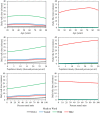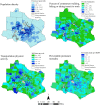Estimating Active Transportation Behaviors to Support Health Impact Assessment in the United States
- PMID: 27200327
- PMCID: PMC4852202
- DOI: 10.3389/fpubh.2016.00063
Estimating Active Transportation Behaviors to Support Health Impact Assessment in the United States
Abstract
Health impact assessment (HIA) has been promoted as a means to encourage transportation and city planners to incorporate health considerations into their decision-making. Ideally, HIAs would include quantitative estimates of the population health effects of alternative planning scenarios, such as scenarios with and without infrastructure to support walking and cycling. However, the lack of baseline estimates of time spent walking or biking for transportation (together known as "active transportation"), which are critically related to health, often prevents planners from developing such quantitative estimates. To address this gap, we use data from the 2009 US National Household Travel Survey to develop a statistical model that estimates baseline time spent walking and biking as a function of the type of transportation used to commute to work along with demographic and built environment variables. We validate the model using survey data from the Raleigh-Durham-Chapel Hill, NC, USA, metropolitan area. We illustrate how the validated model could be used to support transportation-related HIAs by estimating the potential health benefits of built environment modifications that support walking and cycling. Our statistical model estimates that on average, individuals who commute on foot spend an additional 19.8 (95% CI 16.9-23.2) minutes per day walking compared to automobile commuters. Public transit riders walk an additional 5.0 (95% CI 3.5-6.4) minutes per day compared to automobile commuters. Bicycle commuters cycle for an additional 28.0 (95% CI 17.5-38.1) minutes per day compared to automobile commuters. The statistical model was able to predict observed transportation physical activity in the Raleigh-Durham-Chapel Hill region to within 0.5 MET-hours per day (equivalent to about 9 min of daily walking time) for 83% of observations. Across the Raleigh-Durham-Chapel Hill region, an estimated 38 (95% CI 15-59) premature deaths potentially could be avoided if the entire population walked 37.4 min per week for transportation (the amount of transportation walking observed in previous US studies of walkable neighborhoods). The approach developed here is useful both for estimating baseline behaviors in transportation HIAs and for comparing the magnitude of risks associated with physical inactivity to other competing health risks in urban areas.
Keywords: environment and public health; environment design; health impact assessment; transportation; walking.
Figures





Similar articles
-
Walking to public transit: steps to help meet physical activity recommendations.Am J Prev Med. 2005 Nov;29(4):273-80. doi: 10.1016/j.amepre.2005.06.010. Am J Prev Med. 2005. PMID: 16242589
-
Participatory quantitative health impact assessment of urban transport planning: A case study from Eastern Africa.Environ Int. 2020 Nov;144:106027. doi: 10.1016/j.envint.2020.106027. Epub 2020 Aug 19. Environ Int. 2020. PMID: 32827806 Free PMC article.
-
Physical activity-related health and economic benefits of building walkable neighbourhoods: a modelled comparison between brownfield and greenfield developments.Int J Behav Nutr Phys Act. 2019 Feb 20;16(1):11. doi: 10.1186/s12966-019-0775-8. Int J Behav Nutr Phys Act. 2019. PMID: 30782142 Free PMC article.
-
What Is Driving Obesity? A Review on the Connections Between Obesity and Motorized Transportation.Curr Obes Rep. 2017 Mar;6(1):3-9. doi: 10.1007/s13679-017-0238-y. Curr Obes Rep. 2017. PMID: 28243840 Review.
-
Physical Activity Levels and New Public Transit: A Systematic Review and Meta-analysis.Am J Prev Med. 2019 Mar;56(3):464-473. doi: 10.1016/j.amepre.2018.10.022. Am J Prev Med. 2019. PMID: 30777164
Cited by
-
Walkability and urban built environments-a systematic review of health impact assessments (HIA).BMC Public Health. 2023 Mar 17;23(1):518. doi: 10.1186/s12889-023-15394-4. BMC Public Health. 2023. PMID: 36932349 Free PMC article.
-
Routine Assessment of Health Impacts of Local Transportation Plans: A Case Study From the City of Los Angeles.Am J Public Health. 2019 Mar;109(3):490-496. doi: 10.2105/AJPH.2018.304879. Epub 2019 Jan 24. Am J Public Health. 2019. PMID: 30676792 Free PMC article.
-
Co-Benefit Assessment of Active Transportation in Delhi, Estimating the Willingness to Use Nonmotorized Mode and Near-Roadway-Avoided PM2.5 Exposure.Int J Environ Res Public Health. 2022 Nov 14;19(22):14974. doi: 10.3390/ijerph192214974. Int J Environ Res Public Health. 2022. PMID: 36429693 Free PMC article.
-
Time Spent Sitting as an Independent Risk Factor for Cardiovascular Disease.Am J Lifestyle Med. 2017 Sep 1;14(2):204-215. doi: 10.1177/1559827617728482. eCollection 2020 Mar-Apr. Am J Lifestyle Med. 2017. PMID: 32231486 Free PMC article.
-
Air Pollution Health Literacy among Active Commuters in Hamilton, Ontario.Int J Environ Res Public Health. 2023 Jul 3;20(13):6282. doi: 10.3390/ijerph20136282. Int J Environ Res Public Health. 2023. PMID: 37444129 Free PMC article.
References
-
- US Centers for Disease Control and Prevention. Physical Activity Guidelines for Americans. (2008). Available from: http://www.cdc.gov/physicalactivity/everyone/guidelines/index.html
LinkOut - more resources
Full Text Sources
Other Literature Sources
Miscellaneous

